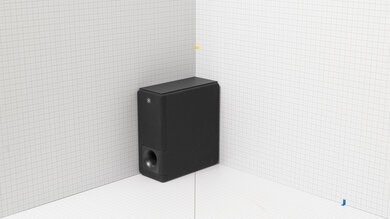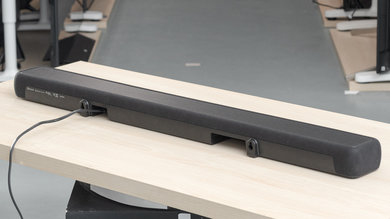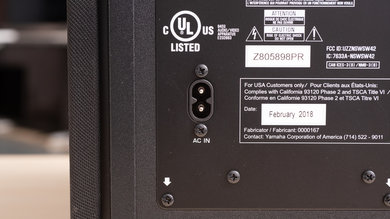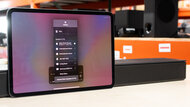The Yamaha YAS-207 is a decent mixed usage soundbar setup. It has a good stereo sound quality, but it won’t provide a real immersive listening experience as it lacks height channels and performs poorly with surround sound channels. This soundbar has a 2.1 configuration, so all 5.1 content will be downmixed to be played. On the upside, the bar is fairly well-made, offers plenty of wired and wireless options, and can get pretty loud. If you’re just looking for a soundbar to play music with good fidelity, play uncompressed files, or if you don’t care that much about a surround experience, the YAS-207 is a great option.
Our Verdict
Decent for mixed usage. The Yamaha YAS-207BL has a good audio reproduction that will be suitable for most music genres and dialogue content like podcasts and audiobooks. However, it has sub-par performance with surround channels and doesn’t support height channels, resulting in a less immersive listening experience. The bar has a small tilt favoring bass frequencies and will be better suited for bass-heavy music genres, but this won’t be too audible for most. Also, its soundstage isn’t that wide, and it will downmix 5.1 surround content down to 2.1.
-
Neutral sound signature.
-
Decent build quality.
-
Good overall stereo performance.
-
Lacks sub-bass.
-
Barebones app.
Good for dialogue. You can use this soundbar to listen to podcasts, audiobooks, or other similar content types. The sound profile is fairly neutral and the overall reproduction of voices will be accurate. It can also get pretty loud and you can also use the Dialogue Enhancement feature to get an even better listening experience. You’ll be able to stream content from your phone wirelessly, but unfortunately, it doesn’t have an auto-volume or night mode to normalize the sound of your different type of content.
Decent for music. The audio reproduction of this soundbar is accurate, but has a slight overemphasis in the bass, adding a bit of boominess. While its soundstage isn’t very wide, it's well-focused and doesn’t sound too defused. There’s not much compression at a moderate volume, but when pushed at the maximum volume, you might hear a bit of pumping and compression artifacts in the bass range, especially on bass-heavy genres. On the upside, you can easily adjust the level of the subwoofer separately.
Okay for movies. This soundbar has good overall audio reproduction, but it doesn’t do well with surround channels. On top of that, the soundstage isn’t that wide and it doesn’t have height channels. All of this will result in a less immersive listening experience. This 2.1 setup will downmix 5.1 content and won’t sound as real as other setups. On the upside, the compression performance is good and you have a few features to customize your sound a bit to your liking, although you won’t have room correction.
- 7.0 Mixed Usage
- 7.4 Dialogue/TV Shows
- 7.1 Music
- 6.6 Movies
Changelog
- Updated Mar 30, 2021: Converted to Test Bench 1.0.
- Updated Sep 27, 2019: Review published.
Check Price
Popular Soundbars Comparisons
The Yamaha YAS-207 is a decent performing soundbar that offers good sound for music and dialogue at an affordable price. It won't be the best option for movies like some high-end soundbars since the YAS-207 doesn't support Atmos. See our recommendations for the best soundbars, the best soundbars under $300, and the best budget soundbars.
The Yamaha YAS-207 is a slightly better soundbar than the Sonos Beam. The Yamaha has a dedicated subwoofer and a better bass extension to produce a thumpy bass. It also has more input selection and supports Bluetooth, but the Sonos' center channel performs significantly better for dialogue-heavy content and has more sound enhancement features than the Yamaha.
The Yamaha YAS-207 is a better 2.1 soundbar than the Polk Audio Signa S2. The Yamaha's sound profile is better balanced and is suitable for a wider range of stereo content. Its subwoofer also creates deeper bass, and the bar creates a better overall phantom center channel. It also features a bit more inputs like a Full HDMI In port. On the other hand, the Polk isn't entirely covered by mesh and feels a bit more durable.
The Sonos Beam (Gen 2) is better than the Yamaha YAS-207 for most uses. The Sonos is a better-built 5.0 setup with a small, standalone design. Unlike the Yamaha, it supports Atmos content and has better center and surround performances. There are also some more sound enhancement features available, like room correction. However, it doesn't come with a dedicated sub like the Yamaha. As a result, the Yamaha reproduces a much more extended low-bass. That said, you can always buy a compatible sub from Sonos to add to your setup separately.
The Sonos Arc is better than the Yamaha YAS-207. The Sonos is a 5.0.2 setup that's better built. Unlike the Yamaha, it supports Dolby Atmos content and has built-in voice assistant connectivity. It also has better soundstage, center, and surround performances and more sound enhancement features available. The Yamaha has a dedicated sub that helps reproduce a more extended low-bass. It also has a Full HDMI In port, unlike the Sonos.
The Yamaha YAS-209 is a slight improvement over the Yamaha YAS-207. It performs a bit better at max volume but doesn't seem to get as loud as the previous model. However, it should still get loud enough for most people. The YAS-209 has a slightly better sub as well, which produces deeper bass. It also now supports Wi-Fi wireless playback, which the YAS-207 lacks.
The Yamaha YAS-207 is better than the TCL Alto 7+. Its audio reproduction is more accurate and great, and it performs better at max volume, although it is a bit quieter than the TCL. It has a Full HDMI In port and supports DTS as well, which the TCL lacks. On the other hand, the TCL is surprisingly well-built and doesn't have any fabric on the bar.
The Samsung HW-Q600A is better than the Yamaha YAS-207. The Samsung is a 3.1.2 setup that's better built. Unlike the Yamaha, it supports Dolby Atmos content. It has a better center channel performance and more sound enhancement features, like a graphic EQ and presets. That said, the 2.1 Yamaha has a better surrounds performance.
Depending on your listening habits, you may prefer either the Yamaha YAS-207 or the Samsung HW-A550. They're both 2.1 setups, but the Samsung is better built. It also comes with more sound enhancement features, like a graphic EQ and presets. That said, the Yamaha has better center and surround performances.
The Samsung HW-Q800A is better than the Yamaha YAS-207. The Samsung is a 3.1.2 setup that's better built. Unlike the Yamaha, it supports Dolby Atmos content. Also, it has better soundstage and center channel performances. There are also more sound enhancement features, like a graphic EQ.
The Sony HT-G700 is a bit better for mixed usage than the Yamaha YAS-207. The Sony is a 3.1 setup that's better-built and supports Dolby Atmos content. It also has a better center channel performance, and it offers more sound enhancement features like EQ presets. That said, the 2.1 Yamaha is able to reproduce a more extended low-bass. It also has a better stereo soundstage.
The Samsung HW-Q60T is better than the Yamaha YAS-207. The Samsung is a 5.1 setup that's better-built and offers a better center channel performance. It doesn't have to downmix surround content into stereo in order to play it, unlike the 2.1 Yamaha. It also offers more sound enhancement features, such as a graphic EQ and presets.
The Yamaha YAS-207 is better than the TCL Alto 5+ in pretty much every test. It sounds better, gets louder, and has better overall performance with center and surround contents. It also has more inputs thanks to HDMI ARC and Full HDMI In ports and supports DTS. However, the TCL is slightly better-built but the difference in performance is too big, making the Yamaha an obviously better choice.
The Yamaha YAS-408 and Yamaha YAS-207 models are very similar. They have about the same sound signature and overall performance. However, the YAS-408 can play content wirelessly via Wi-Fi and AirPlay, which the YAS-207 can't do. It is also slightly better-built and doesn't have any fabric in its design. Overall, the YAS-408 is a better soundbar, but the price difference might not be worth it for some.
The Yamaha YAS-207 is a better soundbar than the Yamaha YAS-108/ATS-1080. It has a separate subwoofer instead of the two built-in subs the ATS-1080 has, which results in better overall bass performance. Also, the rest of the frequency response is noticeably more accurate. Both bars have the same inputs, connectivity options, and app.
The Yamaha YAS-207 performs better than the Sonos Playbar by itself. The lack of subwoofer on the Sonos makes its bass a bit lackluster, while the Yamaha performs great with stereo content. However, the 3.0 Sonos has a dedicated center channel, which is great for voices and dialogue, and the Yamaha is simply a 2.1 setup. The Sonos also has many features, including room correction, but lacks inputs and connectivity options. The Sonos can also easily be upgraded with a sub and satellites, which could make it better performing than the Yamaha.
The Samsung HW-Q70R is better than the Yamaha YAS-207. The Samsung has much more bass extension to produce that thump and rumble, and has a graphic EQ to customize the sound. The build quality is also significantly better on the Samsung, and it has up firing speakers to simulate height in Dolby Atmos content. However, if you watch a lot of dialogue-heavy content, the Yamaha is better.
The Samsung HW-Q60R performs quite similarly to the Yamaha YAS-207, although it's a 5.1 setup. However, due to its configuration, it has a dedicated center channel that is great for clear voices and dialog, which the Yamaha 2.1 doesn't have. The Samsung is also noticeably better-built, has more features, but its stereo sound isn't as accurate and neutral as the Yamaha.
The Samsung HW-R650 is a slightly better performing soundbar than the Yamaha YAS-207, especially due to its dedicated center channel, which is great for voices and dialog. It's also a bit better-built but doesn't have the extended bass of the Yamaha. The Samsung also has more features like a dialog enhancement and night mode, on top of having a graphic EQ.
The Yamaha YAS-207 is a better soundbar system than the Samsung HW-R550. These two 2.1 setups have decent overall performance, but the Yamaha's stereo frequency response is a bit more accurate and neutral. Its center channel performance is also noticeably better and results in more detailed and accurate voices and dialog in movies. On the other hand, the Samsung has more features, is better-built, and is more stylish.
Test Results
The Yamaha YAS-207BL is an all-black and grey soundbar that doesn’t stand out. It's made from plastic and there’s a mesh-like fabric covering most of the sides of the bar. The touch-sensitive controls are on the front, and the top part is covered by plastic with a faux leather-like finish. However, the overall look doesn't feel premium.
The Yamaha YAS-207BL is fairly wide and might not fit between the legs of a TV stand of most 55 inch TVs. It isn't too high and shouldn’t cover the bottom part of your screen unless you have a TV like the Sony A9F or Sony A9G, where the screen is sitting on the table.
This soundbar setup doesn’t have satellites.
The Yamaha YAS-207BL has a decent built quality. The main part of the frame is made from plastic and doesn’t feel as solid as other higher-end models. The bar is also mostly covered by mesh-like fabric that can more easily get dirty and damaged than bars that are made from metal. The mesh is sensitive to ripping, but it shouldn’t be a problem for most if you don’t move the bar around too much. The top part of the bar is covered by textured plastic that looks like faux leather but doesn't feel quite as nice. If the loose fabric is an issue for you, check out the Polk Audio Signa S2 who feels ever so slightly better built and has a tighter fabric covering its speakers.
The Yamaha YAS-207BL has a very good stereo frequency response which results in a neutral and accurate sound profile. The low-frequency extension is only decent though, so while it can produce fairly deep thump and rumble it isn't as good as some higher-end soundbars with more bass, like the HW-Q90R. On the upside, this setup has an accurate audio reproduction in the mid and treble ranges, resulting in great vocals, lead instruments, dialogue, and sounds in the treble range (like S and Ts). Some may feel like it's a bit light on bass, but you can use their Bass Extension setting or adjust the level of the subwoofer to your liking. Also, check out the Yamaha YAS-209, which is the 2019 version of the YAS-207, for a better bass performance.
When listening to the YAS-207, the stereo soundstage is decent. It's fairly small, about the width of the bar, but very focused. On the upside, it doesn’t sound too diffused, which is good because objects seem to be coming from a more accurate pinpoint location rather than from a general area. It sounds more natural than the soundstage of the Bose Soundbar 500, but less wide.
The Yamaha YAS-207BL can get pretty loud, which is good to use in a larger room or a crowded environment. However, when pushed to max volume, you get pumping and compression artifacts in the bass range, especially on bass-heavy content.
The YAS-207's THD performance is very good at normal volume (80dB SPL) and results in a clean sound and great fidelity of audio reproduction. However, when pushing the bar to its maximum capacities, there's a jump in THD in the bass range, but this won’t be audible to most people when playing real-life content.
The Yamaha YAS-207BL is a 2.1 soundbar setup that doesn’t have a dedicated center speaker but still has a good overall performance. It uses the left and right speakers to create a sound in the center, which will sound more diffused and less clear compared to a discrete center. When sending a 5.1 surround sound signal, the YAS-207 will downmix it to 2.1 and will sound as good as how it sounds with a stereo signal, but without an immersive feel.
The YAS-207's audio reproduction when sending surround content to the soundbar is sub-par. Everything is downmixed to a stereo signal since this soundbar is a 2.1 setup. It uses the left and right speakers, which won’t do an accurate and clear representation of surround objects. This means the result won't be very immersive and the objects are perceived to come from the front instead of the sides or behind you.
This soundbar setup doesn’t have height channels and doesn’t support Atmos.
The Yamaha YAS-207 has sub-par sound enhancement features. It's missing Room Correction, which means this soundbar may sound differently depending on your room. There's no Auto-Volume/Night Mode to normalize the sound levels of louder content like commercials when watching a TV show, but it does have a feature to help dialogue sound clearer, even at lower volumes. You can also separately adjust the level of the subwoofer, which is great to adjust the amount of bass the sub is producing. Also, there's no bass adjustment per se, but it does have a Bass Extension feature that gives you the impression of a lower LFE. Although the bar has a 3D surround mode, the sound quality isn't the best when using it. You'll be better off using the normal surround mode, which doesn't sound as bad.
The Yamaha YAS-207BL has just the most common inputs. You have an Optical Audio In, which can be used for surround sound, although you also have an HDMI ARC and a Full HDMI In ports, which can be useful if you want to plug in a game console or a Blu-ray player. You can also plug in your cellphone via the Analog 3.5mm jack if you prefer having a high-quality wired connection instead of Bluetooth for your mobile device.
The YAS-207's supported audio formats over ARC are decent. Over their HDMI ARC port, this soundbar supports Dolby Digital and DTS, which most soundbars do. This means you’ll receive 5.1 surround sound on almost any content that supports it like streaming platforms and Blu-ray discs. Unfortunately, via ARC, you won’t be able to play lossless or object-based formats.
The Full HDMI In allows your soundbar to serve as a hub. Via this port, the soundbar supports both Dolby Digital and DTS, which means you'll be able to play 5.1 audio from streaming services like Netflix and games, which support surround sound. Additionally, 5.1 PCM is also supported, which is rarer on soundbars, so you’ll have uncompressed surround sound performance with sources like a PC or console.
Like most soundbars, the Yamaha YAS-207BL supports both Dolby Digital and DTS via their optical cable. This means you’ll receive 5.1 surround sound on almost any content that supports it like streaming platforms and Blu-ray discs. However, for uncompressed audio, you must use the Full HDMI In to play 5.1 PCM.
The YAS-207 can connect wirelessly only to a Bluetooth source. You’ll be able to connect your phone to the soundbar via Bluetooth, just like you would with wireless headphones. Unfortunately, this soundbar can't access a network and doesn't support Chromecast built-in or AirPlay, and you won't be able to cast from your device to the soundbar.
The YAS-207 can be connected between your TV and another source like a game console to play 4k content at 60Hz. However, it won’t do so for 10bit video signals or for 4:4:4 when connected to a PC. You’ll only get 30Hz passthrough. On the upside, it does support HDR10 passthrough, which can be useful for those who have a Blu-ray player or latest-gen gaming consoles.
The Yamaha YAS-207 remote is very small but offers useful controls. You can switch the input, enable stereo or surround sound, and trigger sound effects like Clear Voice or Bass Extension. You can also control the volume of the soundbar and the sub independently or even mute them. The ‘Dimmer’ key can be used to change the brightness of the LED indicators while the ‘Bluetooth Standby’ function allows the unit to be turned on or off using your Bluetooth device.
Unfortunately, the YAS-207 doesn’t have any built-in voice assistants and you’ll have to use your Android phone via Bluetooth to use these functions. We weren't able to use Siri or Alexa to control the bar.
The Yamaha Home Theater Controller is a pretty basic app but almost offers the same features as the remote. The only features missing inside the app are the Bluetooth Standby and Dimmer. Unfortunately, you can’t play files directly from inside the app and you will rather need to switch to the respective apps you want to use, such as Spotify or Netflix, to be able to control the playback. On the upside, the app works seamlessly and without too much delay.
The soundbar can automatically turn itself off after being idle for a while or when disconnecting the bar from the source. It also supports HDMI CEC, so you can use your TV’s remote to control some of the soundbar features such as volume and power.
Comments
Yamaha YAS-207: Main Discussion
Let us know why you want us to review the product here, or encourage others to vote for this product.








































